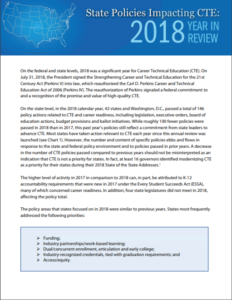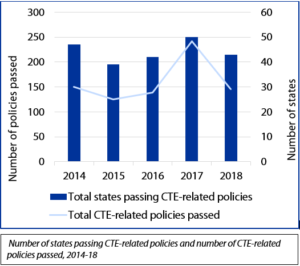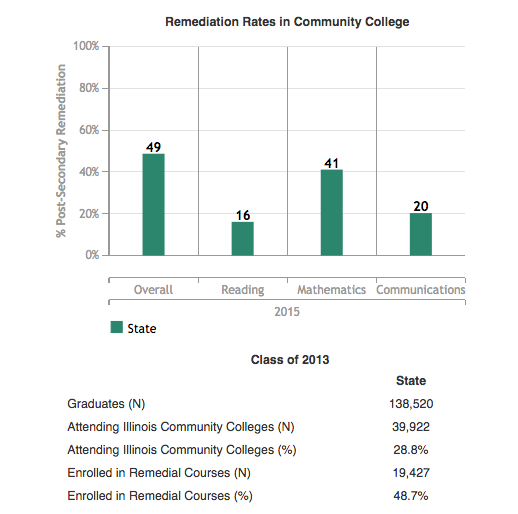![]() There is widespread agreement that high school is too late to begin to expose learners to careers and the foundational skills needed to access and succeed in careers, but there remains a lack of consensus about what CTE and career readiness should entail at the middle grades level.
There is widespread agreement that high school is too late to begin to expose learners to careers and the foundational skills needed to access and succeed in careers, but there remains a lack of consensus about what CTE and career readiness should entail at the middle grades level.
Advance CTE, with support from ACTE, convened a Shared Solutions Workgroup of national, state and local leaders to identify the core components of a meaningful middle grades CTE experience. This collaboration resulted in Broadening the Path: Design Principles for Middle Grades CTE and a companion blog series exploring each of the core programmatic elements of middle grades CTE defined in the paper. In this fifth entry in the blog series, we will examine the core programmatic element of experiential learning, which includes career and technical student organizations (CTSOs).
CTSOs benefit middle grades students by engaging them in learning about themselves, their community and potential careers. These co-curricular organizations provide learners with opportunities to learn about and demonstrate technical and leadership skills, participate in hands-on activities through competitive events and support their schools and communities through service activities.
State and districts around the country are harnessing CTSOs to help middle school students explore careers and their occupational identities. North Carolina, which already offers widespread CTSO opportunities in the middle grades, is revising its approach to middle grades CTE. CTSOs will be one of four key components in a new middle grades CTE framework, which will be supported by 15-hour modules for CTE instructors that address career exploration, essential employability skills, basic concepts and nomenclature, and the integration of CTSO activities within programs. In addition, the state has hired a staff person to focus on middle grades CTE. North Carolina further prioritizes CTSOs in a number of ways, including a section of the Perkins V comprehensive local needs assessment dedicated to evaluating CTSO access and quality at both middle and high school levels.
South Carolina is growing its CTSO participation in middle school. SC HOSA has a middle grades division and an annual middle school conference, including competitive events in medical terminology, health education and health career display. So far, only a handful of middle schools are competing, but these middle schools chapters are engaged and active. For instance, the York Middle School HOSA chapter began in 2016. In addition to competitive events, this chapter has volunteered at a long-term care center, participated in a mock HOSA Bowl with high school peers and connected with HOSA alumni.
Colorado FCCLA opened up opportunities to middle school students in 2011, and Kelly Gauck of Holmes Middle School jumped at the chance to incorporate FCCLA into the family and consumer sciences program. After what she describes as a huge learning curve, all three competitors from the school who attended national competitions in 2013 won gold medals. The chapter has also been very active in its community, making blankets for a local children’s hospital, holding food drives and donating games, toys, food, toiletries and more to those in need. Gauck has been recognized for her work with the national FCCLA Spirit of Advising Award.
As you reflect on this element of middle grades CTE in your state, district or school, consider such questions as:
- Are CTSOs available to all middle grades students?
- Are there efforts to identify and eliminate barriers to access, participation and success in CTSOs for marginalized or special populations of students?
- Are there clear standards for CTSOs, either from a national organization and/or from state criteria for recognition?
- Are educators provided with the time, resources and supports necessary to implement quality CTSO experiences?
- How are middle grades CTSO experiences connected to high school CTSO opportunities?
- How are employers involved in CTSOs through competitive events, mentoring or other activities?
- How are students and their families provided adequate information on CTSO opportunities?
- How are CTSO opportunities evaluated or monitored to ensure student growth?
For additional resources relevant to middle grades CTSOs, check out the Middle Grades CTE Repository, another deliverable of this Shared Solutions Workgroup.



 2018 was a significant year for Career Technical Education (CTE) at the federal and state levels. On July 31, 2018, the President signed the Strengthening Career and Technical Education for the 21st Century Act (Perkins V) into law, which reauthorized the Carl D. Perkins Career and Technical Education Act of 2006 (Perkins IV). The reauthorization of Perkins signaled a federal commitment to and a recognition of the promise and value of high-quality CTE. Additionally, at the state level 42 states and Washington, D.C., passed a total of 146 policy actions related to CTE and career readiness, reflecting a commitment from state leaders to advance CTE.
2018 was a significant year for Career Technical Education (CTE) at the federal and state levels. On July 31, 2018, the President signed the Strengthening Career and Technical Education for the 21st Century Act (Perkins V) into law, which reauthorized the Carl D. Perkins Career and Technical Education Act of 2006 (Perkins IV). The reauthorization of Perkins signaled a federal commitment to and a recognition of the promise and value of high-quality CTE. Additionally, at the state level 42 states and Washington, D.C., passed a total of 146 policy actions related to CTE and career readiness, reflecting a commitment from state leaders to advance CTE. While roughly one hundred fewer policies were passed in 2018 than in 2017, this past year’s policies still reflect a commitment from state leaders to advance CTE. A decrease in the number of CTE policies passed compared to previous years should not be misinterpreted as an indication that CTE is not a priority for states. In fact,
While roughly one hundred fewer policies were passed in 2018 than in 2017, this past year’s policies still reflect a commitment from state leaders to advance CTE. A decrease in the number of CTE policies passed compared to previous years should not be misinterpreted as an indication that CTE is not a priority for states. In fact, 
 Oregon’s Gov. Kate Brown launched the
Oregon’s Gov. Kate Brown launched the  Last month Governor Bruce Rauner of Illinois
Last month Governor Bruce Rauner of Illinois 